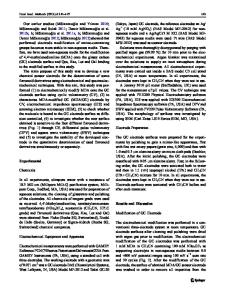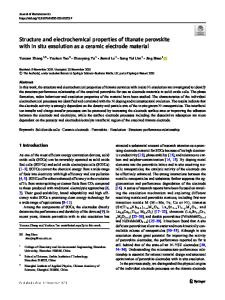Novel Electrode Materials for Ultracapacitors:Structural and Electrochemical Properties of Sol-Gel-Derived Manganese Dio
- PDF / 1,024,182 Bytes
- 7 Pages / 417.6 x 639 pts Page_size
- 15 Downloads / 302 Views
ABSTRACT Nanoparticulate MnO 2 thin films fabricated by the sol-gel process have been shown to be an outstanding novel electrode material for Ultracapacitors. The average specific capacitance of sol-gel-derived MnO 2 thin-films on nickel substrates as determined by cyclic voltammetry ranged from 566 to 698 F/g. These films also exhibited good cycling stability within the potential range of 0.0-0.9V (vs SCE) in unbuffered aqueous electrolyte. Both CV and XPS studies showed that MnO 2 films have remained chemically and structurally intact after 1,500 cycles. The XRD spectra and SEM micrographs showed that the microstructure of MnO 2 thin films are highly porous, and poorly crystalline or amorphous in nature. The high specific capacitance of MnO 2 may be predominantly due to pseudocapacitance associated with homogenous and reversible redox reactions of proton insertion into and out of the MnO 2 lattice. Any variation in the microstructure and thickness of films might affect proton mobility within the oxide matrix and thereby affecting their cycling behaviors. Further optimization of the cycling behaviors is envisaged with better microstructural and thickness control of these sol-gelderived nanoparticulate MnO 2 thin films.
INTRODUCTION Electrochemical capacitors (EC) are charge-storage devices that possess high power density, exhibit excellent reversibility and have very long cycle life. Potential applications of electrochemical capacitors include load-leveling functions for batteries in electric vehicles during starting, acceleration and regenerative braking, and burst power generation in electronic devices such as cellular phones, camcorders and navigational devices. Many charge storage mechanisms have been proposed for electrochemical capacitors, most notably double-layer capacitance and charge-transfer-reaction pseudocapacitance. The large specific capacitance of ultracapacitors are the result of one or a combination of these charge storage mechanisms [1,2]. Double layer capacitance arises from the separation of charge at the interface between a solid electrode and an electrolyte' [2,3], whereas pseudo-capacitance arises from fast, reversible faradaic reactions occurring at or near a solid electrode surface over an appropriate range of potential [4,5].
415 Mat. Res. Soc. Symp. Proc. Vol. 575 ©2000 Materials Research Society
While the utility of MnO 2 in batteries has long been recognized and well established, its potential application as an electrode material for ultracapacitors has not been extensively studied. We believe that the natural abundance of manganese oxide coupled with its environmental compatibility, makes it a very promising electrode material for various energy-storage technologies and, in particular, ultracapacitors. Based on our previous experience in developing nanoparticulate NixO/Ni ultracapacitor systems [6], the present study represents our continuing effort in the search for more economical and environmental friendly electrode materials for the fabrication of ultracapacitors. We report h
Data Loading...










